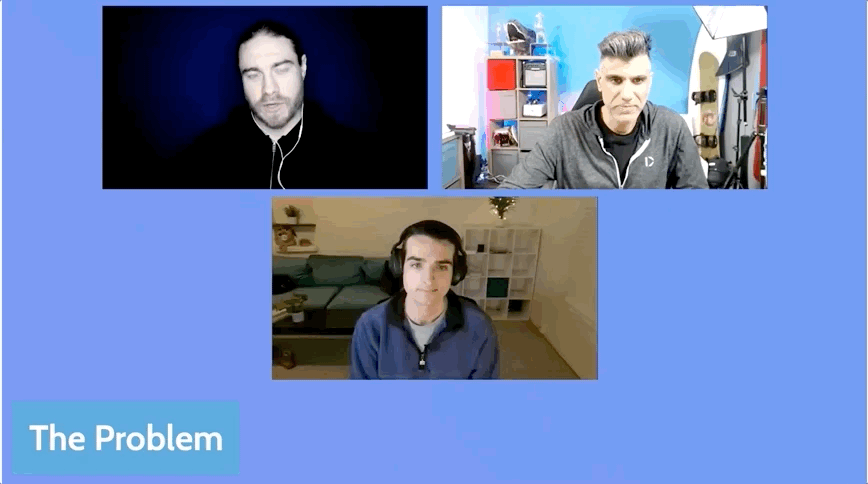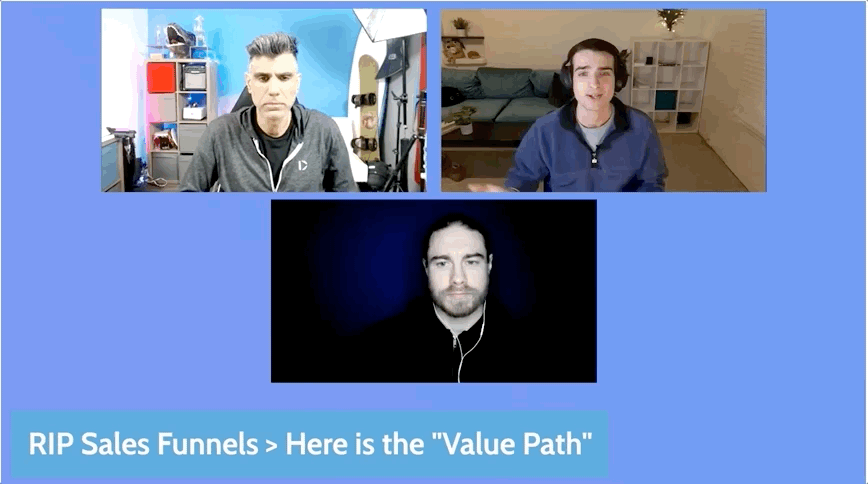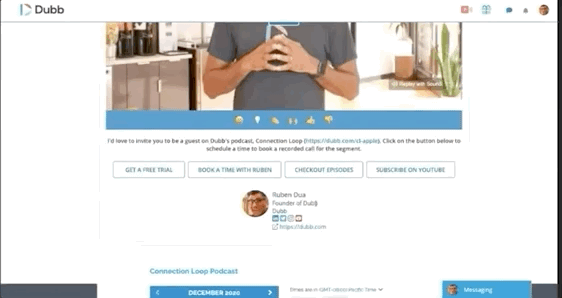Have you been thinking about why to use video for sales and marketing?
In this post, we want to take a deep dive into why video can be such a game-changer for your sales and marketing work. Whether you work at a small startup or a larger company, video can go a long way in helping you accomplish your sales and marketing goals. It is by understanding the power of video in the sales and marketing context that you can leverage all of its attributes in your day-to-day work.
Top Problems That Our Users are Trying to Solve
Many folks approach Dubb by finding us to answer a key problem that they are facing. Simply put, they want to record videos for sales prospecting, developing relationships with their prospects, and getting clients. This is a great start. Video can help you with all of these things.
That being said, those same folks may not realize that asynchronous videos can be extremely useful in the sales context. An asynchronous video, if you don’t already know, is a video that is pre-recorded and sent to a particular audience. Synchronous videos, on the other hand, are live videos. You can think of Zoom videos as an example of synchronous videos and Dubb videos as an example of asynchronous videos.
This observation about asynchronous video is very specific, that’s what our team focuses on. In fact, my colleague Darius Santos has probably pitched thousands of people on the Dubb platform. During those pitches, Darius and our entire team have received feedback which we have then incorporated into our product roadmap.
Finding Better Engagement
Certain subsets of our audience have certain problems. For instance, there is a group that has identified problems in their sales and marketing work and has found the Dubb platform. Specifically, this group wants to obtain better engagement for their messages.

For many people, their traditional methods of engagement—like knocking on doors and attending physical meetings with prospects—simply aren’t there. Covid-19 has made those traditional sales and marketing approaches essentially impossible. Because of this, prospects’ email inboxes are getting flooded. Even if you have a really compelling text email pitch, it may get lost in the shuffle. Along with this, LinkedIn is a great platform to find new prospects, but it has become more difficult to break through the noise.
This is a big problem. There is a more limited ability to get in front of people and share some great data and information about your product or service. Getting attention is always tough, but it is even tougher when more people are using the same strategies or channels to get that attention.
Ultimately, all of our time is limited and we have less time to look at our emails and sift through the massive amount of messages that we are receiving. Because of this, many hard-working and well-intentioned salespeople and marketers are facing more challenges in meeting their internal goals and providing the most value to their prospects and customers.
We often talk about the importance of “interrupting the pattern” when communicating with prospects. You want to stand out and make it much easier for prospects to think about you, your company, and your product or service. While it has become much more difficult to do so recently, the good news is that you still can interrupt the pattern through the use of video.
Reclaiming Our Humanity
Along with this diminishing engagement is the fact that our humanity has been lost in much of our communication. Whether you are sending an SMS message to a key prospect or writing a more general email for your email list, it can be difficult to show off your humanity or personality. Even sending an SMS message with an exclamation point can be misinterpreted one way or the other. One person may interpret that exclamation point as a passive-aggressive statement while another may think that the exclamation point is exaggerating a particular point.
The same observation applies to the words that we use in our text communication. Everything from SMS messages, emails, and even LinkedIn posts can be misinterpreted. Even if we have the best of intentions, a single word or phrase can totally disrupt the flow of the conversation. Separately, some of us may put in the time to write a detailed, custom message for a particular prospect, but then receive a simple “unsubscribe” response. Rejection is never fun, but it can be difficult to see these types of responses after we have drafted a careful, thought-out message to a particular prospect.
We need to get back to this idea of saying, “I am a human being and I care about your problems. I want to help you with your problems and create a long-term, mutually beneficial relationship.” One of the best ways to get back to this humanity is through video. We saw it during the earlier days of the global pandemic. Everyone became familiar with Zoom because it became the go-to app for connecting in a remote-first world. The same can be true of asynchronous video. We can bring that same level of human connection to our interactions, helping all of us reclaim our humanity in our day-to-day work.
Recharacterizing the Business Funnel
Now, I’d like to talk about one problem that may not seem as acute, yet is prevalent in the sales world. That is the frequent use of certain vocabulary or vernacular—particularly the idea of a funnel. It all comes through the mindset of business being a “numbers game.” Essentially, we work a certain number of leads and prospects. A certain subset of those leads and prospects convert into opportunities. Some of those opportunities then become paying clients.
Granted, the logic makes total sense. You can’t avoid numbers in the business world and you need to constantly find new clients to keep your business’s lights on. The problem is the mindset around that. We’re treating human beings like non-humans that are being filtered through a funnel. Some people are going to fall out of the funnel and others are going to convert and close.
While this is how the world works, what resonates more with me is this idea called the value path. Essentially, it adds value and empathy at every step of the way. A critical part of the value path is that no one falls off or exits the path. Those prospects are instead part of a larger tribe and a larger community. Even if they don’t buy your product or service this month or this year, they can add value to your company. They can become a channel partner, an evangelist, or something else. At certain times, this can be even more valuable than that individual becoming a customer or client.

It all comes back to caring about people’s problems. We don’t need to always be focused on that conversion; rather, we should provide value throughout the entire path.
How Video Can Help You Address These Problems
These aren’t the only problems that Dubb users and prospects face in their day-to-day work lives. There are plenty of instances where they want to solve sales or marketing challenges, yet they are struggling to do so.
I’m not saying that video is the be-all and end-all of every single sales or marketing solution. That said, this question of why video for sales and marketing reveals that video can provide a whole host of value for many sales and marketing problems.
Addressing Empathy
For instance, let’s return to this question of empathy. Whenever you are creating any type of content, you need to hone in on the purpose of that content. In the business world, there are many alternative motives when communicating with prospects—most of which involve making some sort of sale. We have to find a way to do a gut check and say, “What would the person on the other end of this message really want to hear? What would they value?”
Much of it comes down to being real and prioritizing the prospect’s wants and needs. Video is the best way to do this. You can actually have a face-to-face conversation with that prospect. You can hear their voice and they can hear yours. Slight intonations of emotion come through in video. It’s impossible to transmit these slight emotions and signals through text. Essentially, video is arguably the most empathetic medium out there. By leveraging video in your sales and marketing work, you can more easily build relationships with any prospect that you are targeting.
Bolstering the Value Path
Video can also help you build stronger relationships along the value path. You can see this with our platform. On Dubb, users can easily make their videos actionable. You can send any type of video to a prospect, but if nothing is actually happening, there is no progress being made for your business. In a business sense, you are going to want an actionable, detailed feature set that can help you lead your prospect down the value path. For instance, with Dubb, a prospect can easily book a time on your calendar. He or she may watch one of your videos and may want to learn more about your product or service. Instead of drafting an email, they can easily select a time on your calendar and click confirm.

In an advanced use case, you can use Dubb to create a whole host of automations for your audience. You can build an automation workflow that sends out certain emails based on your audience’s behavior. Essentially, you can automatically add value along the value path, thereby building closer relationships with your audience at scale.
Ultimately, the intrinsic attributes of Dubb action pages make it much easier to use video for sales and marketing. A good comparison is to YouTube. YouTube is amazing for a reason (it is the world’s second-largest search engine). That being said, YouTube is tougher as a sales or marketing vehicle. Once you send someone to a YouTube link, chances are that they are going to be sent into the YouTube ecosystem. They’ll be watching referral videos based on their personal history. By that point, you may find it much more difficult to bring that prospect into your ecosystem.
From a business perspective, YouTube videos aren’t the most actionable. However, using a tool like Dubb, you can keep your prospects engaged within your own ecosystem. You can lead them down your value path and continue to provide concentrated value.
More Engagement With Your Audience
Returning to the engagement problem, I believe that video can be an extremely effective tool to engage with your audience. Whether an audience member is a cold or warm prospect, video, especially a customized video, is a great way to interrupt the pattern. When Darius trains clients to help them grow their businesses through video, he quickly sees that those clients will never stop using video for their communications. They have learned that it’s an effective way to engage with their audiences and grow their businesses. Their clients love it, they love it, and everyone is happy.
To get that engagement, you need to consistently create valuable content. This may be easier said than done—especially if you don’t know what your audience values. However, once you start to see traction, it becomes extremely exciting. Getting feedback from your initial efforts, it becomes even more motivating to engage with your audience through video.
For some people, that positive feedback happens almost instantaneously. Their prospects or clients respond positively to the video content. Even if they don’t make a sale right away, that awesome feedback is super inspiring and can galvanize you to create even more valuable video content.
Ultimately, video can be your secret weapon when communicating with prospects or customers. It is naturally more engaging and can help you build extremely close connections with your audience. Whether you make video your own way of communicating with your audience or make it your secret weapon in certain circumstances, I’m certain that you’ll see its value.
Staying Consistent and Enjoying the Process
This question of why use video for sales and marketing is relatively straightforward. In practice, however, it can be more complicated.
Part of the difficulty is in staying consistent. YouTube creators, for instance, are known to burn out relatively easily. If you aren’t seeing the data that you expect, it can be hard to continue churning out videos. What we have seen, however, is that the people who succeed on YouTube are consistent.

Along with this, the number one reason that people stop making videos is that they are not making those videos for themselves. If you are creating YouTube videos simply for the fame and the likes, you’ll probably burn out pretty quickly if fame and likes don’t arrive right away. But by staying consistent and creating for yourself, you have a greater chance of reaching your sales and marketing goals.
On the Dubb platform, we have seen that the success of one-on-one videos occurs when users enjoy connecting with people. If you are trying to game the system and build some false connections, video may not be the best tool for you. But if you are doing this for yourself and for creating those great connections with others, you are more willing to stick it out if the results don’t occur right away.
The exciting thing is that the results may come in so many different ways. Videos are evergreen. You can reuse them at different points in time. You may have created a video for one prospect, but you may discover that it really resonates with a completely different prospect. With Dubb, you can make simple and subtle edits to easily repurpose videos for other prospects, so you can also add that level of personalization that your audience expects. You can even use evergreen videos as training assets for new hires. It becomes much easier to teach new sales or marketing staffers if you have already-existing videos of your interactions with prospects and customers.
Throughout this entire process, keep in mind that it is all about the relationship. When I started to believe in it and invest in it, the sales took care of themselves. What motivates me is really enjoying the process of creating relationships. With so many of the relationships that we have created, it’s amazing to look back.
Take Action Today
As I have contemplated it, I think my best definition of marketing is this idea of making so many connections with so many people that eventually, you don’t need to do any sales. The sales come to you because so many people out there are enjoying your product or service and are part of your tribe. You are building an ecosystem where individuals come to you that are already interested in your product or service.
So how can you get started building this ecosystem? In other words, if you really want to address this question of why use video for sales and marketing, what can you do right now?
For one thing, don’t hesitate to use Dubb. You can use Dubb both in the professional context and the personal context. I’ve discussed some of the features that you can find within the Dubb platform, but click here if you want to learn more. You can also click here to sign up for a free seven-day trial of our premium plans.
From there, go ahead and create one video using Dubb. Once you are done creating that video, send it to a friend that you haven’t spoken with in a few months. It can be virtually anything and you can send that video to virtually anyone. You can even include a video reply call to action so that the recipient can send a video back to you. By getting into the habit of creating content, you will start to see just how valuable video is.


